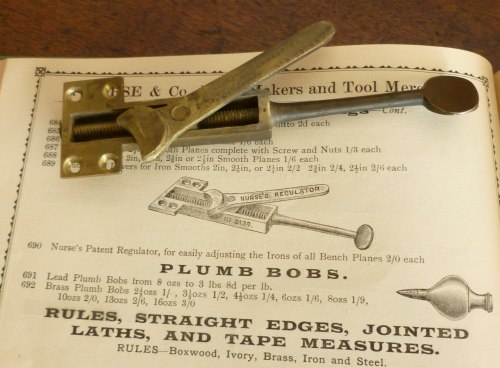 The most successful plane blade adjustment mechanism of all time is the yoke arrangement invented by Leonard Bailey and used on Stanley bench planes since the mid 19th century. But the idea of a blade plane adjuster on a plane goes back earlier and there are many designs before and since that tried to carve out a slice of the market. The most successful plane blade adjustment mechanism of all time is the yoke arrangement invented by Leonard Bailey and used on Stanley bench planes since the mid 19th century. But the idea of a blade plane adjuster on a plane goes back earlier and there are many designs before and since that tried to carve out a slice of the market.
As anyone who has used a quality wooden plane a wedge plane is pretty easy to adjust but it takes a bit of practice. However as the 19th century wore on more amateurs enjoyed woodworking and the quality of wooden planes dropped. One important mark of quality in a wooden plane is the fit of blade and wedge and adjusting a plane with an ill fitting wedge is far less reliable.
In the last decade of the 19th century a major London hardware store "Charles Nurse & Co." decided to do something about it. The "Nurse Regulator" as it was called is a pretty clever design, was made to be easily retrofitted to a wooden plane, and very easily mass produced.
About 6" overall, it is mostly three cast parts. A body the screws on to a mortise cut in the plane; a cast screw and long turnscrew (the screw is chased on after casting) for depth adjustment; and a swinging lever that engages the iron at the top of the cut slot and also supplies lateral adjustment capability. The lateral adjuster pivots on a small brass block that rides on the screw, captured by the frame. Everything is riveted together. It's clever! But very few people bought it.
We don't exactly know why it didn't catch on but we can guess - the customers with skill to mortise the regulator into the back end of a plane were skilled enough not to need a regulator. It cost money, Nurse was a small company, maybe too small for an aftermarket device to gain any traction. Another possibility is that it didn't work too well. The threaded column in the nearly unused sample in the photograph isn't perfect because of a casting flaw.
Nobody knows how many of these adjusters were made, they are rare, and while Work Magazine for one, occasionally had ads for the regulator, by and large outside a Nurse catalog they are unknown. It's rare. In 25 years I can only recall one, maybe, and then this unused regulator dropped out of the sky.
My plan is at some point to install this regulator or a copy in a wooden plane and see how it works. My guess is that if properly made it might be a little better than a Norris type adjuster and certainly have a stronger lateral adjustment. I think the chances of it being better than a Stanley adjuster are zero. However one reason that the Stanley adjuster was never used on wooden or iron planes was that a key to those designs was a wooden frog for bedding the iron, which meant that there was no space for an adjustment yoke behind the iron.
After nearly a 100 year run Charles Nurse & Co. finished up 1937. They were innovators and were one of the early importers of American tools such as Stanley planes. The English hand tool world of the late nineteenth and twentieth centuries is loaded with innovative designs as the tool industry tried to compete with the flood of American inventions. The Norris plane adjuster of 1913 was a successful design (even if Stanley Victor planes used the same design a generation previous) and I thought it is interesting to see what another contender in the plane market tried to do.
|
 Joel's Blog
Joel's Blog Built-It Blog
Built-It Blog Video Roundup
Video Roundup Classes & Events
Classes & Events Work Magazine
Work Magazine


 The most successful plane blade adjustment mechanism of all time is the yoke arrangement invented by Leonard Bailey and used on Stanley bench planes since the mid 19th century. But the idea of a blade plane adjuster on a plane goes back earlier and there are many designs before and since that tried to carve out a slice of the market.
The most successful plane blade adjustment mechanism of all time is the yoke arrangement invented by Leonard Bailey and used on Stanley bench planes since the mid 19th century. But the idea of a blade plane adjuster on a plane goes back earlier and there are many designs before and since that tried to carve out a slice of the market.